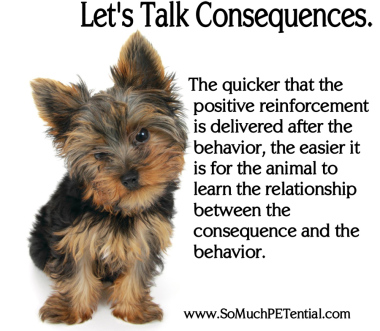Let’s talk about consequences.
That is, after all, the essence of how animals operantly learn whether or not a behavior is worth repeating or not. If a behavior serves to get the animal something of value (from the animal’s perspective), then that behavior will be repeated and even strengthened.
 That is such a simple but very important concept to understand; and yet it is also one of the great complications in relationships because we inadvertently reinforce behaviors we do not like while forgetting to reinforce wanted behaviors all the time. Actually reinforcement for unwanted behaviors is all around if we do not manage the environment carefully enough.
That is such a simple but very important concept to understand; and yet it is also one of the great complications in relationships because we inadvertently reinforce behaviors we do not like while forgetting to reinforce wanted behaviors all the time. Actually reinforcement for unwanted behaviors is all around if we do not manage the environment carefully enough.
Think about the contained dog who has learned that climbing a fence results in unbelievably awesome freedom to sniff flowers, greet strangers or play with other dogs. Do you think that dog will be more or less motivated to climb the fence in the future? What about the dog who has learned that bumping his human causes his human to get up and get treats? Or the dog who has learned that barking at the door gets the door to open and fun people to walk through? Or the bird who has learned that screaming gets humans to pay attention?
The list of examples for operant learning is endless. It is why we can say, so long as two living beings are together, one is always shaping the behavior of the other.
Training wanted behaviors
Let’s put this in the context then of teaching wanted behaviors. It is not enough to just talk about consequences in a general sense.
Clarity in teaching is how we help our learners to understand exactly what behavior it is that we are wanting to see. We build clarity by teaching in an environment where the animal can focus (with no to minimal distractions in the beginning), when the animal is motivated to learn, with small enough steps so as to help him succeed, and by providing immediate feedback following the behavior that tells our student, “YES” this is exactly what we are looking for and reinforcement is coming.
At a recent workshop I took from Dave Kroyer, he referred to this immediate feedback as moment markinig because it involves very precise timing of clicking (or using a verbal marker) within a second from when the wanted behavior is performed. And the quicker that the positive reinforcement is delivered after the behavior, the easier it is for the animal to learn the contingency relationship between the consequence and the behavior.
This is the beauty and the power of the clicker in training. (And since that workshop, I am using a lot more clickers in my work.) Clickers provide a very precise and quick tone without the fluctuations of human voice which means clear and immediate feedback for the learner (so long as the click sound is always followed by something of value to the animal).
Dave shared a statistic with us that learning can occur 50% quicker with a clicker for these reasons. And this ironically occurred just after a trainer clicked seconds late, accidentally marking the wrong behavior of her dog. Guess which behavior her dog repeated? I have seen that happen before also. A lot of behaviors can take place in a matter of seconds – a head turn, movement, tail wag to name a few – and whichever behavior occurs just before the click is the one that you are marking.
You can practice your timing without your learner present in a number of ways.
Here are a few ideas:
Watch tv and a video and watch for a specific word or action to click or mark verbally.
Drop a ball or small pieces (one at a time) of something and click or mark verbally the instant the piece hits the ground
When clicker training with your pet, always remember that you must always follow the click with something of high value to your student to keep motivation high.






